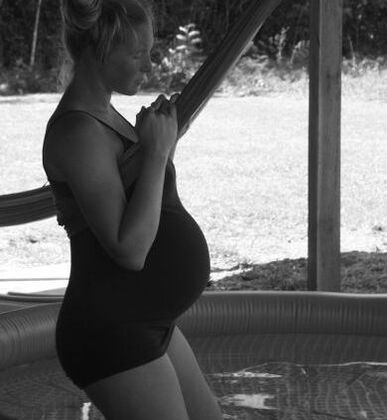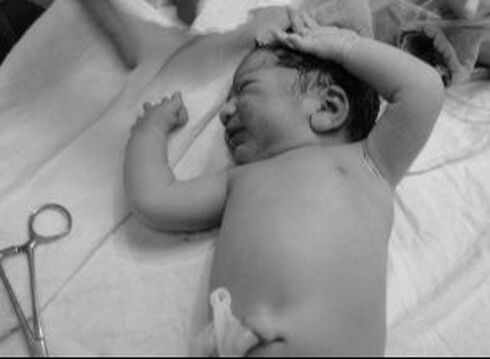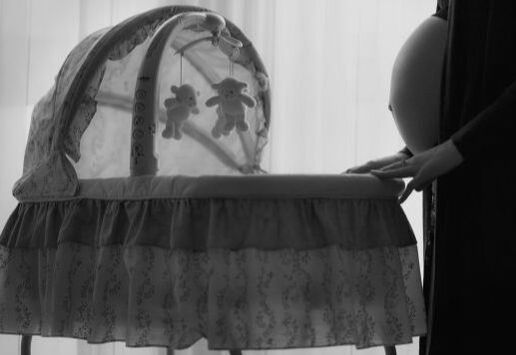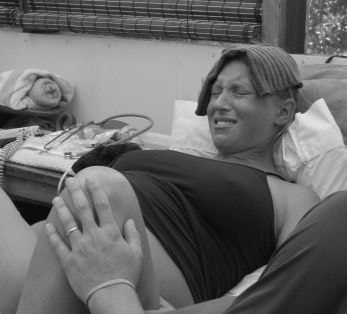|
|
How Labor Works
One of the first things I would like to mention is that, there is no such thing as "false labor". So many mothers get discouraged and think they have failed when they call their doctor or midwife and say they think they are labor only to be told that it is "false labor". Every contraction counts! It is all working toward the goal of your baby being born. These early contractions are called "prodomal labor".
There are a lot of changes happening in your body before the first stage of active labor begins (where your cervix are dilating). The cervix themselves have to get in position, soften and shorten before they open. These changes can happen over time and these changes are important and there is nothing "false" about them! So if you are ever told that you are in "false labor", do not be discouraged, just think it as early labor and know that your body is doing exactly what it is suppose to do!
Weeks before you go into labor, your body is already preparing the uterus and cervix for the process. It is this process that brings about so many of the symptoms which women experience in the days and weeks before labor. A main purpose of the uterus is to contract and push out your baby. During pregnancy, the body keeps the uterus relaxed to allow your baby to gestate (grow to maturity) until baby's organ systems are mature enough to be able to survive outside of the womb. For labor to occur, the uterus must be brought back to action and primed for its final job.
It is believed that the class of hormones known as prostaglandins are the catalysts for this awakening process. The prostaglandins are "tissue hormones".....that is, they are secreted by the same tissue in which they work in (unlike hormones such as the thyroid hormone which is produced in a gland and circulates to many tissues via the blood stream). There are many different types of prostaglandin hormones.....each with slightly different chemical structures and thus, different jobs. Some prostaglandins are responsible for the disappearance of connective tissue in the cervix. When this occurs the cervix softens, effaces (thins out). Ultimately, with uterine contractions, will dilate or open. Other prostaglandins prepare the uterine muscle cells for efficient contraction by making them more sensitive to the hormone, oxytocin, which is produced in the brain. (A synthetic form of oxytocin, Pitocin, is often used to try to induce labor or strengthen uterine contractions during labor.)
Many tissues throughout the body can produce prostaglandins. The action of prostaglandins late in pregnancy may also explain the uncomfortable aches that pregnant women feel in the lower back, pelvis, and hips in the days and weeks before labor.
One of the first things I would like to mention is that, there is no such thing as "false labor". So many mothers get discouraged and think they have failed when they call their doctor or midwife and say they think they are labor only to be told that it is "false labor". Every contraction counts! It is all working toward the goal of your baby being born. These early contractions are called "prodomal labor".
There are a lot of changes happening in your body before the first stage of active labor begins (where your cervix are dilating). The cervix themselves have to get in position, soften and shorten before they open. These changes can happen over time and these changes are important and there is nothing "false" about them! So if you are ever told that you are in "false labor", do not be discouraged, just think it as early labor and know that your body is doing exactly what it is suppose to do!
Weeks before you go into labor, your body is already preparing the uterus and cervix for the process. It is this process that brings about so many of the symptoms which women experience in the days and weeks before labor. A main purpose of the uterus is to contract and push out your baby. During pregnancy, the body keeps the uterus relaxed to allow your baby to gestate (grow to maturity) until baby's organ systems are mature enough to be able to survive outside of the womb. For labor to occur, the uterus must be brought back to action and primed for its final job.
It is believed that the class of hormones known as prostaglandins are the catalysts for this awakening process. The prostaglandins are "tissue hormones".....that is, they are secreted by the same tissue in which they work in (unlike hormones such as the thyroid hormone which is produced in a gland and circulates to many tissues via the blood stream). There are many different types of prostaglandin hormones.....each with slightly different chemical structures and thus, different jobs. Some prostaglandins are responsible for the disappearance of connective tissue in the cervix. When this occurs the cervix softens, effaces (thins out). Ultimately, with uterine contractions, will dilate or open. Other prostaglandins prepare the uterine muscle cells for efficient contraction by making them more sensitive to the hormone, oxytocin, which is produced in the brain. (A synthetic form of oxytocin, Pitocin, is often used to try to induce labor or strengthen uterine contractions during labor.)
Many tissues throughout the body can produce prostaglandins. The action of prostaglandins late in pregnancy may also explain the uncomfortable aches that pregnant women feel in the lower back, pelvis, and hips in the days and weeks before labor.
When preparing for your birth, it is best not to have a specific birth plan. Keep an open mind and realize that birth is different for everyone and just because it may not go the way you plan doesn't mean that it can't be a positive experience.
Pain in labor is a is not something to be scared of, it is there for a reason. For some women it is helpful not to think of it as pain, but more like, "waves of pressure". With each wave getting you closer to your baby. Most people will react to pain by tensing and fighting it, but if you do this during labor, it will only slow everything down and make it last longer. Labor and childbirth are not some kind of illness that you need to do something about or try to fix it.
Labor pain should be thought of as "pain with a purpose" as the end result will be you holding your beautiful baby!
Contractions build gradually and allow the body's natural endorphins to reach their peak and to allow your mind to accept the pain as it increases. The pain or pressure will change with each stage of labor. Every woman’s contraction pattern is unique. Many women birth babies just fine with what many doctors might call ‘ineffective’ contraction patterns. When you are left alone to birth how ever you want, your labor pattern will be as unique as you are.
First Stage:
In the first stage, intensity needs to increase as the contractions increase to allow the physiology of labor to progress.
Second Stage:
In the second stage, when you are pushing, the pain is different, intense, more expulsive and at the point when the head crowns the pain is there, to tell the mom to take it slowly so her body can stretch and gently birth her baby.
Third Stage:
In the third stage, the pain is there to let the mom know when it is time to birth the placenta.
If a women is allowed to relax and believe in her body, then she is more able to cope with and accept the discomfort. Most pain relief doesn't take away the pain as completely as it sounds like it would, but it can help dull the pain or distract you from it. For instance, when you have a headache and you take something for the pain, it usually helps but doesn't take the pain completely away. Pain relief does not have to come from a medicine form. Changing positions and moving around can help with discomfort in labor, so does deep breathing, finding a focal point, atmosphere, partner, massage, encouragement, working on relaxation and listening to your body and releasing tension.
Some women who have gotten an epidural, later regret it, because they feel disconnected from their bodies, they have to be told when they are having a contraction or when to push and sometimes they end up tearing because they couldn't feel the pain to tell them to slow down and allow their body to adjust. A lot of women who have had medication at one birth and then try the next time without, say that it is so empowering without the pain killers and they feel more connected with their bodies and their baby when they didn't have the drugs.
It is a personal decision that each women must make for themselves. Whatever a mother decides to do, she should remember that the pain of labor is there for a reason. We need to understand it and accept it and not be afraid of it, it is our body's way of guiding us!
Here are the 3 stages of labor:
First stage:
Consists of 3 phases, early labor, active labor and transition. Most of the time that you will spend in labor is in this first stage. This is when your contractions are helping your cervix to dilate (open) and to efface (thin out), so that your baby can pass through. The contractions are also helping your baby to move deeper into your pelvis.
Early labor 0-4cm.
This is the longest stage. Can go on for days or weeks. It is common for a mom to walk around 2-3cm dilated for a while.
Some women do not even know they are in labor at the beginning of the early phase.The contractions can be pretty far apart, maybe 10 -30 min apart and not totally regular yet. Some women just think they are having back ache or more braxton hicks (practice contractions).
Contractions are sort of like waves that build to a peek then gradually subside. At the peek of a strong contraction the uterus rises noticeably and becomes very hard. The contractions will gradually become more frequent until they are less than 1 minute apart. Also, lasting more than a minute at a time, at the point when you are ready to push.
Your water may or may not break in this phase, every women is different. You will definitely want to get as much rest as possible in this phase, so that you aren't too tired for pushing your baby out later. You might want to shower in early labor, so that you can start out feeling fresh and water can be very soothing. As your labor progresses it is very good to keep walking and moving around to keep your labor progressing.
Active labor 4-8 cm.
This when things speed up, you will be having regular contractions and you will be wanting to make plans to go to the hospital or call your midwife. On average, it can take about four to eight hours for a woman having her first baby to go from 4 centimeters to full dilation. However as labor and birth are unpredictable and it can be shorter or longer than that.
Active Phase
In this phase contractions become more intense and progress to about 3 minutes apart and lasting much longer than before. As the contractions get more intense and your body is getting down to business, it will take more focus and concentration on relaxing and breathing through them. During active labor, some women find that making noise (called vocalization), with contractions helps to keep them relaxed during the contractions.
Many women also find that tuning out the world around them, sometimes referred to as "going inside yourself" can help them stay more relaxed and handle the contractions better. You may start to feel a little tired and want to rest between contractions. You may be less aware of things going on around you.
This is when your support team starts coming in handy, having someone to help you focus and work through each contraction can be very helpful. They may keep reminding you to change your position and drink your water, putting a cool rag on your head, remind you to use the bathroom regularly. Having a full bladder can increase the discomfort of contractions. Also for some women sitting on the toilet helps them to relax your pelvic floor muscles and the cervix then dilate quicker.
Transition 8-10cm
This is often considered the hardest or most intense part of labor but also the shortest, thankfully. Some moms go through this very smoothly and others need a little help. This is the time when your cervix are dilating the last few cm. The last few contractions are very intense and different, like rapid choppy waves, not giving you time to catch your breath. Some moms feel as if they are losing control at this point and will need a little extra support. You may feel like they are cold or shivering and then hot or nauseous, they may have hiccups or burping or urge to push or rectal pressure or shaking. This all comes from the intense changes in hormones. You have to remember THIS WILL NOT LAST LONG!
There are other signs of transition, such as, restlessness, irritability, discouragement (thinking you can't go on), panicking, drowsy, sensitive, crying or withdrawn. All of these are normal and you just might need some extra encouragement and firmness at this point letting you know that you can do this and that you are almost done and you will be holding her baby soon. You may feel a little panicky but you just can't give in to it ! Your birth support, whether a friend,husband or doula may need to remind you, not to give in to any high screaming sounds but keeping your sounds low and focused. Screaming will tense your body up and this will only make your pain worse.
Nausea is very common in labor and will most likely hit during transition, if it didn't before. If you feel the urge to push, your Dr. or midwife probably tell you to blow through it for now. If you push too early before the cervix are completely dilated it can cause cervical swelling and complications. Don't panic if you feel your body start to push some without you trying, it is a natural reflex and will be fine if you don't try to help it. As soon as transition is over there is usually a pause, when you can relax before pushing. It can last anywhere from roughly 10 - 30 minutes.
Stage 2:
Stage 2 is delivery of your baby.
Pushing can take from 15 min. to 3 hours roughly. For some moms this is a great relief and something for them to focus on and work at, a step closer to their baby. Some women have a short pushing stage and others have a longer one. It all depends on how well you are able to push and the size of your baby.
For some first time moms it can be hard to get the hang of pushing, as you are using muscles near the rectum and most women tend to want to hold back, afraid of having a bowel movement. The body naturally prepares for labor by emptying the bowels, most women will get diarrhea a few days before they go into labor. Mothers also have the option of doing an enema if they are worried about this. There is one thing about labor that many women learn in birth class, but if you aren't taking a class it might be surprising. As you are pushing and baby lowers into the birth canal, you will feel like you are going to have a bowel movement. This is completely normal! You have to do your best to relax your butt muscles and not fight this feeling. So knowing ahead of time will help you be prepared to try and just go with it instead of fighting it. The wall between your vagina and colon is quite thin and a baby moving down through your vagina will naturally affect the colon also. Tensing your butt is very counter productive and will only cause birth to take longer. You will make faster progress if you can relax your whole butt! You will have to let go of your worries and just focus on getting your baby out.
Some women get excited and just want to keep pushing even when your body isn't contracting but you will just wear yourself out that way. The pushing will be much more effective with the help of the contraction. So it is best wait and push with your contractions. Once the baby moves down, the head will start to become visible with each pushing contraction. The baby's head will move down and then slightly back up when the mother stops pushing. This allows the body to slowly stretch and adjust and helps the mom not to tear. For some moms seeing their babies head with a mirror will help them to find the strength finish pushing. As the head moves down and gets to the point where it does not go back in at all, the mother will begin to feel what some call the "ring of fire" , better known as crowning. At this point it helps most mothers to reach down and feel their babies head. It will give them the strength and encouragement they need to push through the burning and get their babies head out.
Once the head is out, your dr. or midwife will usually tell you not to push so that they can check to make sure the cord is not around your babies head, so you may have to breathe and pant for a minute. Then you will be allowed to continue pushing your babies shoulders out, which is usually only a few pushes more. Then you will be holding your baby!
Stage 3:
The shortest and easiest stage is delivery of the placenta. Usually delivery of the placenta happens moments after your baby is born but sometimes can take longer. This part does not seem difficult at all after the birth of your baby. Usually one push and it is out.
After your baby is born and the placenta is out your Dr. or midwife will regularly check the uterus to make sure that it is going back down properly. They will most often massage your uterus a few times when they check on you, to stimulate the contractions to encourage it to go down, like it is suppose to. This can be quite uncomfortable, so just keep that in mind and do your best to relax and breathe through it. It will only last a few minutes.
Over the next few days you will most likely experience what is called "after pains". These can be quite uncomfortable, like small contractions. Which is basically what it is, your uterus is contracting and shrinking back to it's normal size. No one told me about this before I had my first baby and I was caught off guard. So at least you can be prepared and not worry about what is happening.
So what normally causes labor to begin?
There is a protein released from the lungs of the baby initiates a surge of chemical events leading to the start of mom's labor. The initiation of term labor is carefully timed to begin only after a baby is sufficiently mature to survive outside the womb. A Drs. Carole Mendelson said "Women who go into preterm labor frequently have an infection of the membranes that surround the fetus, and the number of macrophages in the wall of the uterus increases with the initiation of preterm labor. When women go into labor in their own time, at term, they also have an increase in macrophages in the uterus,"
So when a mother goes into labor on her own, this is a strong sign that her baby is ready to be born and that her body is ready for labor.
How do contractions feel?
Contractions are a very hard thing to describe to someone that has never felt them. I remember when I was pregnant with my first baby wanting to know what to expect. So for those of you out there, that are expecting your first baby, I will try to put it into words for you.
A contraction may start with a small tingle somewhere in your low abdomen and then grow and grow, passing to the surrounding muscles, with a sort of cramp like feeling. Some women say it is like a dull ache that grows in strength. It can spread to your back, or down near the tailbone, and start to ‘dig’ into the muscles. It could also be described like a "wave" that grows in intensity, while you breathe through it in big deep breaths, trying not to fight your body… until you can feel the contraction start to ‘let go’ and ease back down again. Sometimes this takes longer than you would expect but, at least you know that it’s almost over and you can feel the release.
For me contractions started very low in my stomach near the pubic bone and felt like a strong period pain. Then there was a tightening that would sort of crawl up and around to the top of my stomach. The tightening and squeezing, was the dominant feeling. I was pleasantly surprised when I was in labor with my first baby, that the contractions weren't as bad as I had imagined. The contractions were quite intense at times and I had to focus on breathing through them but I could handle it!
Since everyone has different levels of pain tolerance and different ways of describing things, you probably won't get two same answers. I have three children and the contractions felt a little different each time I was in labor. The position of your baby can effect how uncomfortable your contractions are. For instance, with my second child, my baby had dropped very low into my pelvis, almost a month before he was born. So during labor with each contraction I had more pain in my tail bone area than in my stomach. For me when I was about 8cm. dilated and I got into the birth pool, it was an amazing relief! I wished I had gotten in sooner, It made all the pain so much easier to handle!
For my sister though, when she had her second baby he was turned with his back to hers and it caused a more painful back labor. She said the contractions started in her back with a very strong, sharp feeling and worked it's way around to her low stomach. She said the heat of a hot water bottle or heating pad on her back ,was what got her through it.
I asked several mothers to describe what they think contractions feel like, so I will share with you here what they said....
"A deep, squeezing pressure, that at times took my breath away."
" For me, labor always started out with cramps and then slowly worked towards contractions. I guess I would have to say that the pain is like cramps that become greater in intensity as the labor progresses until it feels like extreme cramps! Along with that, it feels like every muscle in your abdomen is tightening all at once during each contraction."
"Feels like a big tightening, a hardening, of seemingly ,your whole abdomen (even though it's only the uterus muscle)."
"To me it was just and intense pressure, in my low stomach. Not what I would call pain but they kind of took my breath away."
"With my 1st two babies my labor started out with hard contractions right off....they felt like real bad stomach flu cramps or food poisoning & stayed that way. With my 3rd I had what you read about in books...the mucus plug coming out, then just mild cramping (like mild period cramps)...then the hard ones. With my 4th baby, my water broke first then I progressed like I did with the 3rd."
"A squashing wave. That starts gentle and gets stronger to a peak and then fades away again."
"It was like a deep growing ache, starting very low and working up my stomach and around my back."
"I would say the contractions themselves were easier than I expected. They were intense and I had to concentrate, but they weren't really what I would call painful. I never felt out of control."
"Well, back labor is a whole different ball game. It was like intense growing pains in my back, like nothing I have ever felt. I needed a heating pad and firm pressure on my back with each contraction. Very different from my first birth."
Signs of labor:
1. More regular and stronger contractions, which is your bodies way of preparing for labor. It is all a step closer to your birth.
2. The mother may also notice a slight weight loss of 2 or 3 lbs.
3. Baby may be a little less active, not as much room to move.
4. Mother may have a burst of energy trying to clean and prepare for the baby.
5. Loose bowels as the body cleans out to prepare for birth.
6. Mother may have increased vaginal discharge.
7. May lose mucus plug, (looks like snot with pinkish blood).
8. Cervix may start effacing (thinning out) and dilating (opening).
Timing contractions:
Knowing how to time contractions is important. Start by looking the time when each contraction starts and writing it down, then write down the time when it stops. You can count the time from the end of one contraction to the beginning of the next one, to see how far apart they are. Call your Dr. or midwife when contractions are about 5 min apart or when water breaks (if you haven't already). Contractions usually begin irregularly and get more regular. Pay attention to how strong they are and how close together, so that you can get an idea of what stage of labor you might be in. If your water breaks you need to let your Dr. or midwife know right away, since the the amniotic fluid is what protects the baby against outside bacteria and infections. So the baby will need to be born within a certain amount of time after the water breaks. When your water breaks it can be a big gush or a slow constant trickle either way is fine and not a problem.
What to eat:
If you think you are in labor it can helpful eat small healthy snacks to give your body energy but not over load it. Just listen to your body and if you are hungry try eating a little something.
Some good options might be: yogurt, juice, crackers and cheese, fruit, pasta salad, peanut butter and banana sandwich, tea with honey (for energy), or granola.
Some things you might want to consider having ready for your birth:
1. Music and something to play it on.
2. Candles, if you think they would be relaxing.
3. Lotion or oil for massaging the mom.
4. Chap stick, as your lips may get dry.
5. Hair clip to keep your hair out of your face.
6. A second hand watch and pen and paper for timing contractions.
7. Some essential oils such as peppermint to help with nausea or jasmine or lavender oil to keep mom calm and relaxed. Jasmine oil is also supposed to help strengthen contractions.
8. A birthing ball to bounce through your contractions on.
9. Camera, the take photos of labor and birth or at least your baby when it is born.
10. A birthing pool to labor in or you may even want a water birth.
11. A hot water bottle to put on your back or belly during contractions to help with the pain. ( A hot water bottle is a rubbery pouch that you fill with hot water. You can get them at most stores in the pharmacy section.)
12. A birthing stool to sit on.
13. A small mirror so you can see your baby's head as it is born, if you want. (This can help you to find strength for your last few pushes.)
14. Some extra pillows to lean on or prop yourself up.
These are just a few things that I used during labor with my three babies. As a doula I have brought or suggested these things to many other moms as well and they found them helpful also. If you are interested, you can get a few of these things from the links below.
|
|
|
|
|
In the passed it has been very common for doctors and midwives to check your cervical dilation to try to judge the progress of your labor. However, the cervix only shows us part of the picture – contractions may have done a great job of turning a baby and moving him down but maybe not opened the cervix much. Your cervix opens so unpredictably and uniquely that you cannot determine what is going to happen or how soon, just from what a cervix is doing right now. You can go from a being dilated only to 3 cm. to giving birth within minutes or stay at 8cm for hours – your cervix can even close back up. I have personally seen situations where a mom got all stressed out or scared or even just having someone in the room that she wasn't comfortable with and it caused her cervix to actually start going backwards and closing again. It is sooo...very important that a mom stayed as relaxed and uninterrupted as possible during labor!
Pushing Baby Out
Dilation of the Cervix:
Dilation of cervix must be complete before baby can be pushed out. Complete dilation is 10 centimetres, this is when the cervix is fully open and the baby can further descend into the birth canal (vagina) during the pushing (second stage) of labor.
Pushing:
One is the commonly practiced method of pushing is called coached or directed pushing,where you are directed to begin pushing as soon as you're fully dilated, whether or not you feel an urge to.
Women who birth with a doctor are most likely to be directed in pushing, they are often told when to push or not to push and how to breathe or how hard to push etc. It is normal to be told to stop pushing because of a cervical lip, or because you aren't dilated enough, or to check for an umbilical cord as baby is coming out.
So most women go into birth thinking that they will need to be told how and when to push and for how long etc. Movies and TV shows also cause this, with birthing scenes of controlled breathing and pushing, and women panting, blowing and screaming as they push their babies out.
The argument for being told when to push, goes along with the idea that once you are fully dilated it is just time to push and mothers aren't told to listen to their bodies or how they feel. They think that since women can't possibly know how dilated their cervix are without being told, then they need to be told to push too. This is common in medical births where epidurals are used because this intervention causes woman not to be able to feel what is happening in their bodies.
There is research showing directed pushing has negative outcomes on oxygenation to the baby and trauma/injury to the mom. Fetal and maternal distress can also be negative consequences of such pushing. The alternative approach, often favored by midwives, is known as spontaneous pushing.
So the cervix are now completely opened and the baby's head is in position. The baby will now start to leave the uterus. You may feel the urge to push right away or sometimes the mother doesn't feel it for a while. Some women find that they have to learn to push. It takes time and concentration. You will find yourself holding your breath and bearing down, similar to when you have a bowel movement, but much more intense. Relaxing the vaginal area as you bear down is especially important to remember, because by tensing the muscles in this area, you will actually be fighting against the birth of your baby. It will also be more painful if you tense up!
The contractions will be different now. The muscle of the mothers chest and belly contract along with the uterus now, pushing the baby down the birth canal. Often with the beginning of a contraction you will feel pressure in your bottom and vagina, which is the urge to push. As you feel your baby move down you my feel anxious to get the baby out and try to push between contractions, but you don't want to do this! It will wear you out to quickly. So just try to go with your body and what it is tell you to do.
With the urge to push most women feel the need to make noise. Which can be good, as long as you keep the sounds low and your mouth loose. Some midwives believe that there is a connection between the mothers mouth are her cervix. So the theory is, that if her mouth stays relaxed then her cervix will also.
You will feel your baby slowly move down a little at a time and then slip back up a little and then moving down a little further again. Don't panic when you feel baby move back up, this is a normal process to keep the baby from coming to fast.
As baby's head moves down you will probably start feeling some pressure and a burning sensation. This is you baby's head starting to crown. At this point you may want to hold back, as you feel burning or like you might tear. This is when the hot towels on your perineum help so much! The warmth will help you relax and work through this feeling. Just remembering that a few more pushes and your baby's head will be out.
You might also now feel like, if you push again that you may have a bowel movement. Many women will stop pushing because of this. Don't let that hold you back, it may happen. I know it sounds crazy, but it is a normal part of birth and in that moment you just have to focus on your baby. It may or may not happen to you, everyone is different. It will be cleaned up quickly and no one will hardly notice.
Many women have diarrhea just before you go into labor, it is natures way of cleaning you out for this stage. You also have the option of having an doing an enema in early stages of labor if you want.
At this point the only way to end the burning is to get it out, so really try to concentrate on bearing down. Once the head is out your dr. or midwife will have you quit pushing for a few minute as they check for the cord around the baby's neck. Then you baby should be out in a few more pushes.
Here are some pushing tips:
1. Push as if you're having a bowel movement. Try to relax your body and thighs! Put all your concentration and focus into the pushing not into worrying about anything accept getting baby out. For some women it helps to tuck your chin to your chest. This will help you focus your pushes to where they need to be. It might also help to look down below your navel so you remember where your pushes should originate from. Really try and go with what your body wants to do.
2. Stay focused on feeling your baby. Maintain control and try to avoid frantic pushing, you don't want to push with your upper body or strain your face. Listen to when you get the urge to push and go with it.
3. Sometimes, if the pushing isn’t moving your baby down effectively, it may be helpful to change positions. Trust your instincts! Take a few deep breaths while the contraction is building so you can get plenty oxygen to baby. As the contraction builds, take a deep breath and then push with all of your might, holding your breath as you do. There’s no magic formula to pushing. Do what comes naturally.
4. Follow the urges you feel to push, and your baby will be born. Your body knows what it is doing!
5. Rest between contractions as much as you can, even dosing off if you feel like it. You'll need to save up your energy and rest up for the next round of pushing, is hard and intense work.
6. Looking in a mirror can help. Once your babies head starts to be visible, watching and reaching down and touching it, may give you the inspiration you need to push when it gets tough. Keep in mind though, that pushing is a two steps forward one step backward process, so don't be surprised when your baby's head crowns and then slides back in again. This is your body's way of protecting your body by allowing it to stretch a little at a time.
7. It can help to encourage you to keep pushing, if you reach down to feel your baby's head. It's so close now!
We often think of the mother as doing all of the work during labor. This is actually not true. During the first stage of labor the baby is twisting and turning trying to find the path of least resistance to allow themselves to be born. During the second stage of labor, as the uterus is pushing the baby and mom is working on pushing, many times the baby is also pushing and wriggling itself out through the birth canal, choosing positions to make it's birthing trip easier. It is quite an amazing process!
|
|
DISCLAIMER : Nothing on this site is meant in any way to be medical advice! Any questions or problems you may have, should be discussed with your caregiver! Thanks!









